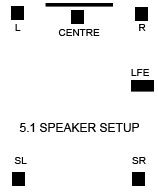In the early days of film making, movies were made with images only, no sound. In 1927, however, a new era was entered with the movie “Jazz Singer’, in which sound was introduced. This was the first step in theatre sound-effects technology, one that has led to major developments in the industry. Movie sound technology began with monaural sound and has evolved to include stereophonic and Surround Sound.
 |
||
| Sony STRDG720 7.1 Audio Video Receiver |
Now, there are a number of advanced technologies that significantly improve audio performance in movie theatres. These advanced technologies include Dolby Digital, DTS, and the THX system. As with most of the technology that was first seen in theatres, high tech surround audio systems can now also be enjoyed at home. There are a few formats on the market now that have developed as time goes on so in this series we are going to take a look at various surround sound technologies.
In a movie theatre viewed from above, you would find the speakers are arranged so as to surround the audience. Speakers are placed In front of the screen along the walls to the left and right of the audience and to the rear.
By contrast, at home it is not easy to arrange the same equipment in the same position as in the theatre because of differences in room size and layout as well as acoustical problems. The most popular layout is the 5.1 layout that usually consists of left and right front, centre, and 2 surround speakers normally placed near the rear. Hence the 5 for the 5 audio channels in the room, the point 1 actualy refers to the Low Frequency Effect (LFE) speaker also known as a subwoofer. Dolby Pro Logic II was the first system to use this format, the earlier Pro Logic system was known as a 4.0 system despite having 5 speakers as the rear surround were mono and it also lacked a subwoofer.
Dolby Pro-Logic was the first major step forward in home theatre systems it encodes a centre and rear channel in the existing analog audio tracks, a good effect could be achieved with a pro-logic amp. Today’s Dolby Digital and DTS systems use a totally digital signal to achieve 5.1 channels and are far superior.
 |
All six speakers are controlled independently in the Dolby Digital and the DTS sound systems as apposed to the earlier analogue Pro Logic systems. There are even extensions to the two competing formats that see even more speakers added to your lounge room with 6.1 and 7.1 systems.
Most amps sold today are backward compatible, therefore if you purchase a DTS amp you will be able to play Dolby Digital and Pro-Logic signals as well as the DTS signals. In order to get the benefit of a Dolby Digital or DTS amp you will need a digital cable ran from your audio source, your CD or DVD play may have a single plug on the back labeled digital out or SPDIF next to the standard left and right cable. you will need to run this to you amp to benefit from digital surround sound. A Pro Logic system lacks this connection as it is a totally analogue system decoding the 5 channels from the left and right channels. With a digital surround system digital audio is fed from your DVD into your amp where it is processed into the separate channels.
Leave a Reply